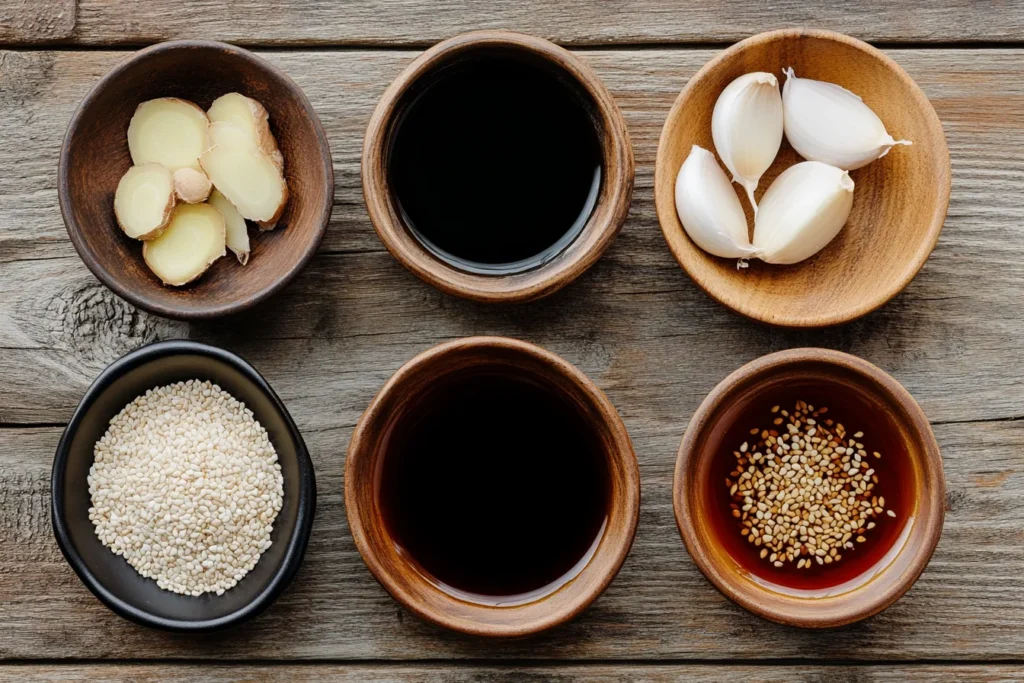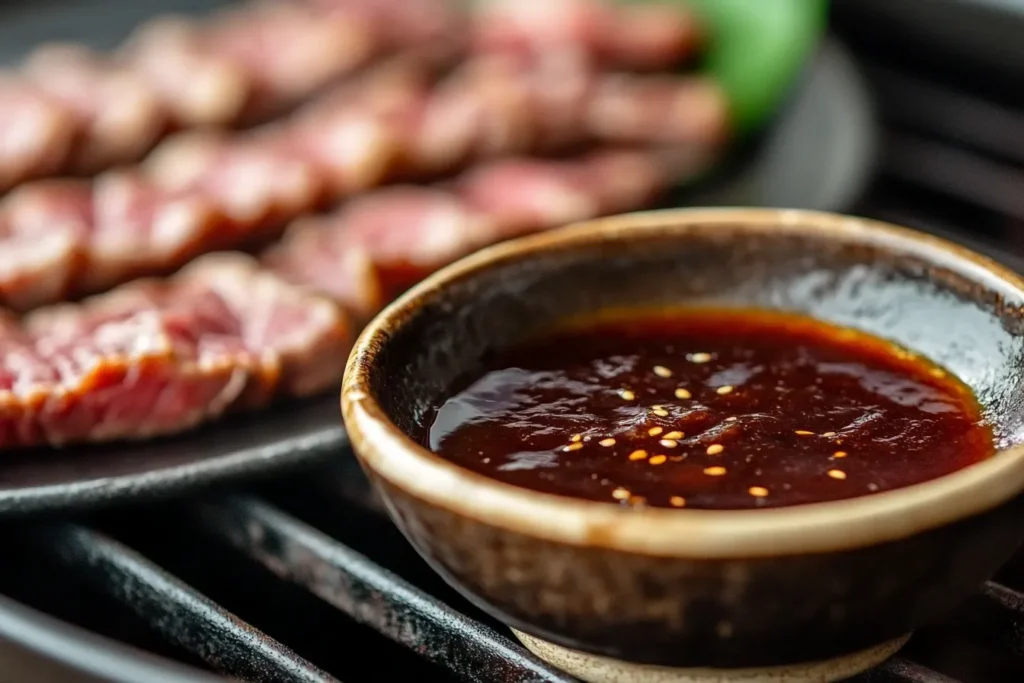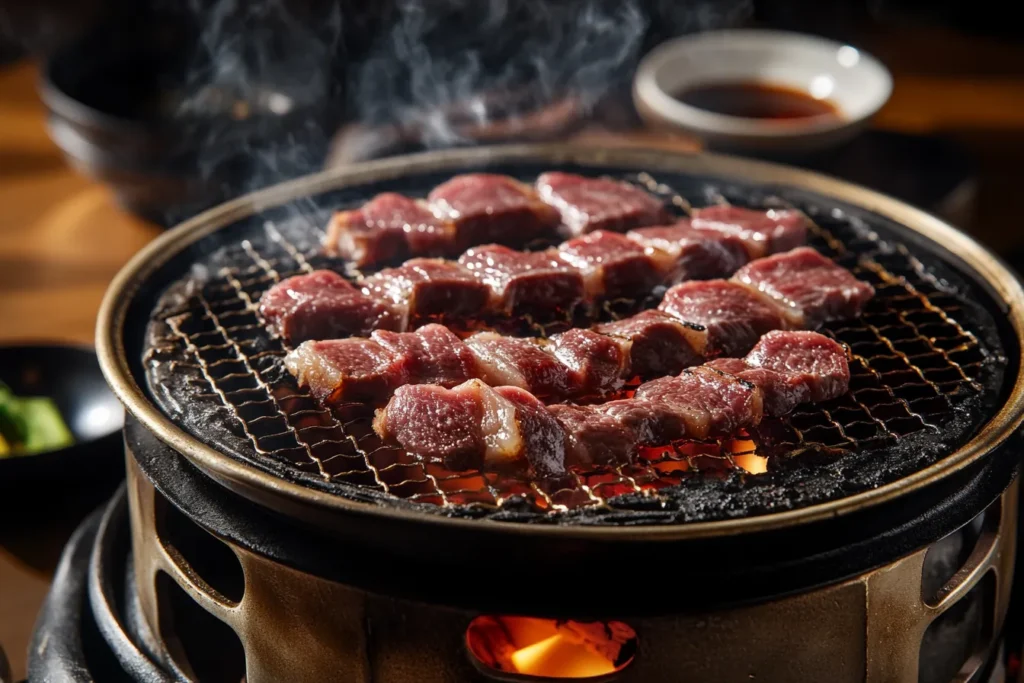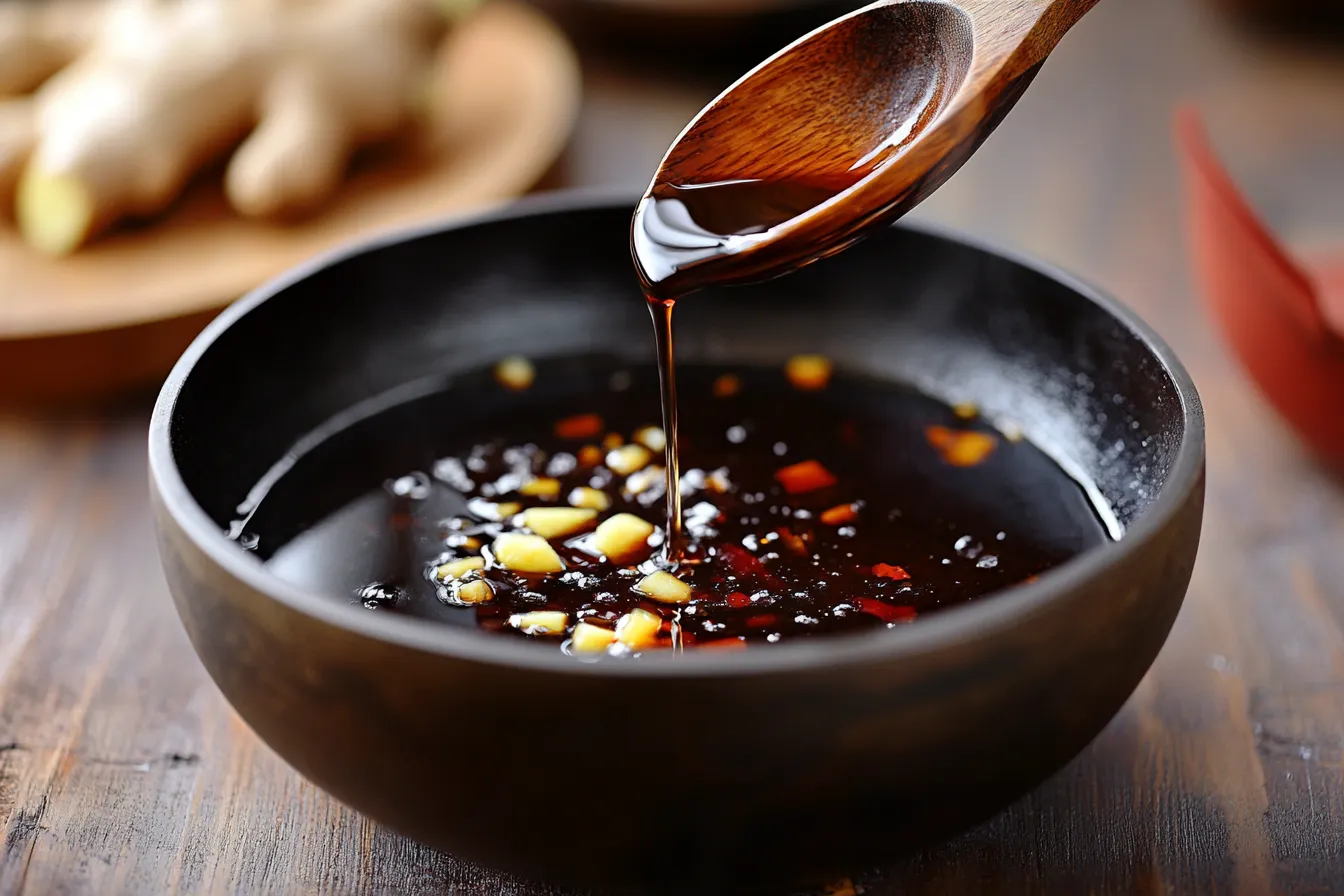Introduction
If you’ve ever enjoyed Japanese barbecue, there’s a good chance you’ve dipped a sizzling slice of beef into the rich, sweet, and savory perfection of yakiniku sauce. This essential condiment is more than just a simple dipping sauce — it captures the very soul of Japanese grilling. Bursting with flavors of soy sauce, garlic, sesame, and sweetness, yakiniku sauce elevates even the simplest cut of meat into a mouthwatering masterpiece.
Today, yakiniku (which literally means “grilled meat”) has become a global favorite, with yakiniku restaurants popping up around the world. Whether you’re grilling at home or looking to recreate restaurant-quality Japanese BBQ, learning about yakiniku sauce — how to make it, use it, and choose it — can bring the joy of authentic Japanese flavors straight to your table..spicy sauce used in many tunisian dishes
In this guide, we’ll explore everything you need to know about yakiniku sauce, from its origins to its traditional ingredients, plus easy homemade recipes and expert grilling tips. Ready to unlock the magic of Japanese barbecue? Let’s dive in!
What is Yakiniku Sauce?
Yakiniku sauce is a flavor-packed Japanese condiment traditionally served with grilled meat. Unlike simple soy sauce, yakiniku sauce balances salty, sweet, umami, and sometimes spicy flavors in a way that complements the smokiness of barbecue.
Many people think of it only as a dipping sauce, but yakiniku sauce is also used as a marinade, glaze, and even a stir-fry seasoning. Its rich depth of flavor comes from a combination of ingredients like soy sauce, mirin, sugar, garlic, ginger, sesame oil, and sometimes fruit purée, giving it a complex, layered taste.
Whether you’re preparing a classic wagyu beef yakiniku or a plant-based grill platter, this sauce is the bridge that brings Japanese barbecue flavors to life.
Origin and History
The word yakiniku comes from the Japanese words yaki (grilled) and niku (meat). This style of grilling evolved during the early 20th century, inspired by Korean BBQ traditions brought to Japan. Over time, Japanese chefs refined the concept, creating their own marinades and sauces suited to local tastes.
Yakiniku sauce itself grew popular after World War II, when grilled meat restaurants boomed in urban centers. Today, you’ll find a huge variety of yakiniku sauces in Japanese supermarkets and specialty shops, and many families proudly make their own custom recipes handed down through generations.
Meaning of “Yakiniku”
“Yakiniku” literally means grilled meat, but it also describes a lively dining experience. In a yakiniku restaurant, guests grill thin slices of meat themselves over charcoal or gas burners right at the table. This communal, interactive cooking style is part of what makes yakiniku so beloved in Japan.
The sauce is essential to the experience — it’s not just an afterthought but a centerpiece of flavor that ties the meal together..Mango Habanero Sauce Recipe

Ingredients of Traditional Yakiniku Sauce
Yakiniku sauce is a carefully balanced blend of traditional Japanese flavors, designed to bring out the best in grilled meats and vegetables. Let’s break down its core ingredients to understand why it tastes so irresistible.
Soy Sauce Base
At the heart of any yakiniku sauce is soy sauce. This deeply umami ingredient provides the salty backbone of the sauce, harmonizing perfectly with rich, fatty meats. Traditional Japanese soy sauce (shoyu) is brewed from soybeans, wheat, salt, and koji, and its savory complexity is hard to match.
Some homemade recipes will also blend in tamari, a gluten-free soy sauce alternative, to deepen the sauce’s umami flavor or to make it accessible for gluten-free diets.
Sweeteners: Sugar, Mirin, Honey
Sweetness is critical to balancing the salty and umami profile of soy sauce. Yakiniku sauce usually uses a combination of white sugar and mirin, a sweet Japanese rice wine. Mirin adds both sweetness and a subtle tang that complements grilled meats beautifully.
Other variations might substitute honey for a rounder, floral sweetness or even brown sugar for a deeper molasses-like note. This sweet balance prevents the sauce from tasting harsh or overly salty.
Garlic and Ginger Flavors
No yakiniku sauce would be complete without the bright, aromatic punch of garlic and ginger. These ingredients cut through the richness of grilled beef and pork, adding a fresh, zesty layer to the flavor.
Garlic is usually finely grated or minced, while fresh ginger is grated to release its juices. Together, they add complexity and depth that pair perfectly with charred, smoky meats.
Sesame and Other Aromatics
Sesame is another signature flavor of yakiniku sauce, whether as toasted sesame oil or ground sesame seeds sprinkled on top. The nutty, roasted character of sesame complements the caramelization of meat cooked over high heat.
In addition, some yakiniku sauces include a dash of chili flakes or gochujang (Korean fermented chili paste) to add gentle heat, highlighting the influence of Korean BBQ culture on yakiniku. Others might even add a touch of grated apple or pear to introduce natural fruity sweetness.
This symphony of ingredients creates a sauce that is sweet, salty, tangy, garlicky, and deeply savory — the perfect match for anything you throw on the grill.
How to Make Yakiniku Sauce at Home
Ready to try making yakiniku sauce from scratch? It’s surprisingly easy and uses ingredients you may already have in your pantry. Here’s how to get started.
Basic Recipe
A traditional yakiniku sauce recipe usually follows this simple formula:
- 4 tablespoons soy sauce
- 2 tablespoons mirin
- 2 tablespoons sugar
- 1 tablespoon sesame oil
- 1 tablespoon grated garlic
- 1 tablespoon grated ginger
- 1 tablespoon rice vinegar
- 1 teaspoon toasted sesame seeds
Combine these ingredients in a small saucepan. Bring to a simmer over medium heat, stirring constantly until the sugar dissolves and the flavors blend, about 2–3 minutes. Let it cool completely before using as a dipping sauce or marinade.
Spicy Yakiniku Variation
If you like a kick of heat, try adding:
- 1 teaspoon gochujang or chili paste
- ½ teaspoon crushed red pepper flakes
This variation brings a satisfying, gentle spiciness that pairs beautifully with grilled pork belly or short ribs.
Vegan-Friendly Version
Most traditional yakiniku sauces are vegan since they don’t contain animal products, but you should watch out for certain commercial sauces that might include fish extracts.
For a guaranteed vegan sauce, stick with the homemade version and check that your soy sauce and mirin are plant-based. Add extra grated apple or pear to boost sweetness naturally, and enjoy dipping your favorite grilled mushrooms or tofu.

Best Ways to Use Yakiniku Sauce
One of the best things about yakiniku sauce is how versatile it is. Whether you’re grilling wagyu beef slices or pan-frying mushrooms, this sauce transforms any ingredient into a flavor-packed bite. Let’s explore the most popular ways to use it.
Dipping Sauce for Grilled Meats
The classic way to enjoy yakiniku sauce is as a dipping sauce for grilled meats. After searing thin slices of beef, pork, or chicken on a hot grill, simply dip each piece into a bowl of yakiniku sauce before eating. The sweet-salty flavors enhance the smokiness of the meat and add a refreshing tang that balances fatty cuts.
If you want to elevate the dipping experience even further, sprinkle a pinch of sesame seeds or sliced scallions into your sauce bowl for extra crunch and aroma.
Marinade for Beef, Pork, or Chicken
Yakiniku sauce is also a brilliant marinade. Because it contains soy sauce, mirin, sugar, garlic, and ginger, it does double duty to both tenderize and season the meat.
To use it as a marinade, place your sliced meat in a resealable plastic bag or shallow dish, add enough sauce to coat, and let it sit for 30 minutes to two hours. Longer marination will help the flavors penetrate more deeply, especially for thicker cuts of beef or pork.
Just remember that yakiniku sauce has a fair amount of sugar, so keep an eye on the grill to prevent burning.
Pairing with Vegetables
Grilled vegetables are fantastic with yakiniku sauce, too! Bell peppers, zucchini, mushrooms, and eggplant all soak up the sauce’s savory sweetness beautifully.
You can brush a thin layer of sauce onto the vegetables while grilling, or use it as a dipping sauce just like with meat. For a plant-based yakiniku night, tofu and tempeh also taste amazing with a drizzle of this sauce.
Tips for Buying Store-Bought Yakiniku Sauce
If you’re not in the mood to make yakiniku sauce from scratch, there are excellent store-bought options out there. However, not all sauces are created equal — so here’s what to look out for.
Label Reading
Always check the label to see what ingredients are inside. The best yakiniku sauces should list soy sauce, sugar or mirin, garlic, ginger, and sesame oil as their main ingredients.
Avoid sauces that list high fructose corn syrup or excessive artificial flavorings, which can make the sauce overly sweet or flat. Also, if you need to stick to a gluten-free diet, look for certified gluten-free options that use tamari instead of wheat-based soy sauce.
Recommended Brands
Some of the most reliable store-bought brands include Ebara, Kikkoman, and Mizkan, which produce authentic yakiniku sauces widely available in Asian supermarkets and online. These brands stick close to traditional Japanese flavor profiles and are generally well-balanced in sweetness, acidity, and umami.
If you’re curious about experimenting, Korean-style BBQ sauces can also work as a substitute, though they usually have a spicier, more robust flavor compared to classic Japanese yakiniku sauce.

Popular Yakiniku BBQ Techniques
If you truly want to experience the magic of yakiniku, mastering the right grilling techniques is just as important as perfecting the sauce. Let’s look at how to bring authentic yakiniku grilling into your kitchen or backyard.
Grilling Over Charcoal
Traditionally, yakiniku is grilled over a charcoal fire. Charcoal imparts a distinct smoky aroma that pairs beautifully with yakiniku sauce’s sweet-savory flavors. At yakiniku restaurants, diners often use a small grill with high-quality binchotan charcoal, which burns hot and clean with minimal smoke.
When grilling over charcoal at home, make sure the coals are fully ashed over before cooking, and keep a close eye on thin cuts of meat to prevent burning. Lightly oil the grill grates to keep meats from sticking, and grill in small batches so you can enjoy the freshest flavors straight off the fire.
Indoor Tabletop Grilling
For many people living in apartments or with limited outdoor space, indoor tabletop grills are a fantastic alternative. These electric or gas-powered grills recreate the communal yakiniku experience without the hassle of a full charcoal setup.
Tabletop grilling also allows you to control the heat more precisely and reduces smoke, making it perfect for an indoor dinner party. Pair a tabletop grill with small bowls of homemade yakiniku sauce, fresh vegetables, and thinly sliced meats for an authentic Japanese-style feast.
For an even deeper dive into Japanese barbecue culture, check out Japanese BBQ traditions from MasterClass.
FAQs
Can I freeze yakiniku sauce?
Yes! Homemade yakiniku sauce freezes well for up to three months. Store it in an airtight container or freezer-safe bag, and thaw it overnight in the refrigerator before using. Give it a good stir after thawing to re-blend any separated ingredients.
How long does it last in the fridge?
Yakiniku sauce can be refrigerated for about one to two weeks if stored in a tightly sealed jar or container. Always use a clean spoon when serving to avoid introducing bacteria.
Is yakiniku sauce gluten-free?
Traditional yakiniku sauce uses soy sauce, which often contains wheat. If you need a gluten-free option, use tamari-based soy sauce or look for certified gluten-free versions on the market. Always check product labels carefully, since some commercial sauces also contain barley or other wheat-based thickeners.
What’s the difference between yakiniku sauce and Korean BBQ sauce?
Korean BBQ sauces, such as bulgogi or kalbi marinades, often have a spicier and more robust flavor, sometimes including gochujang (Korean chili paste). Yakiniku sauce, by contrast, is generally milder, with a stronger focus on soy sauce, garlic, and sweetness.
Can I use yakiniku sauce for stir-frying?
Absolutely! Yakiniku sauce makes a delicious stir-fry sauce. Simply add it to a hot wok with vegetables and protein of your choice for an easy, flavorful meal. Since it contains sugar, keep the heat moderate to prevent scorching.
Where can I learn more about Japanese grilling?
For a deeper look into authentic Japanese yakiniku and BBQ culture, visit Japanese food culture or explore yakiniku grilling tips on Serious Eats. These resources will expand your knowledge about Japanese cooking traditions.
FAQs (continued)
Can I customize yakiniku sauce to my taste?
Yes! That’s the beauty of homemade yakiniku sauce. If you like it sweeter, add more mirin or a bit of honey. Want more tang? Increase the rice vinegar. Love garlic? Feel free to double the amount. Many Japanese home cooks tweak yakiniku sauce to their family’s preferences, so don’t be afraid to experiment until you discover your own perfect balance.
Is yakiniku sauce healthy?
Generally speaking, yakiniku sauce is relatively healthy, especially when made at home with whole-food ingredients. It’s low in saturated fat and provides plenty of flavor, so you don’t have to use much to make grilled meats and vegetables exciting. However, because it contains sugar and sodium, it’s wise to use it in moderation if you’re watching your salt or sugar intake.
Does yakiniku sauce go bad?
Yes — like any condiment, yakiniku sauce can spoil over time, especially homemade versions without preservatives. Always refrigerate it, store in a clean container, and use within 1–2 weeks. If the sauce smells sour or you see mold, throw it out immediately.
Conclusion
There’s a reason yakiniku sauce has become a staple of Japanese barbecue culture: it’s a perfectly balanced blend of sweet, salty, garlicky, and umami-rich flavors that brings out the best in grilled meats and vegetables. Whether you’re dipping, marinating, or stir-frying, yakiniku sauce transforms simple ingredients into a restaurant-worthy meal.
The beauty of this sauce is how simple it is to make at home — using basic pantry staples, you can create an authentic Japanese BBQ experience in your own kitchen. And if you prefer the convenience of store-bought bottles, there are plenty of excellent brands to choose from.
By understanding its ingredients, mastering grilling techniques, and exploring how to use yakiniku sauce in new ways, you’ll open up a world of Japanese flavor right at your dinner table. So gather your family, fire up the grill, and let yakiniku sauce work its delicious magic.

Name: Yakiniku Sauce
Ingredients
Equipment
Method
- Instructions:
- Combine soy sauce, mirin, sugar, sesame oil, grated garlic, grated ginger, rice vinegar, and sesame seeds in a small saucepan.
- Place the saucepan over medium heat and bring to a gentle simmer.
- Stir constantly until the sugar is dissolved and the flavors meld, about 2–3 minutes.
- Remove from heat and let cool completely.
- Serve as a dipping sauce, marinade, or glaze.
